Scarlet Diva Blu-ray Movie
HomeScarlet Diva Blu-ray Movie 
Film Movement | 2000 | 91 min | Rated R | Sep 25, 2018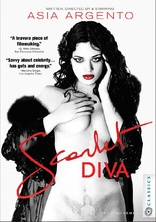
Movie rating
6.1 | / 10 |
Blu-ray rating
| Users | 0.0 | |
| Reviewer | 3.5 | |
| Overall | 3.5 |
Overview
Scarlet Diva (2000)
Anna Battista is a popular, 24-year-old Italian-born film actress who embarks on a hectic and self-destructive spree across Europe and to America to shed her "boy-toy" image so that she can write, direct and star in a semi-autobiographical film entitled "Scarlet Diva." After working in Rome, and winning a prestigious award in Milan, Anna travels to Paris, where her best friend is trapped in an abusive relationship, and where she meets and falls in love with a rock star who abandons her. Later, she is attacked by a sleazy but powerful producer. All the while, Anna struggles to find her own voice and pursue her artistic vision.
Starring: Asia Argento, Vera Gemma, Herbert Fritsch, Francesca d'Aloja, Daria NicolodiDirector: Asia Argento
| Erotic | Uncertain |
| Drama | Uncertain |
Specifications
Video
Video codec: MPEG-4 AVC
Video resolution: 1080p
Aspect ratio: 1.85:1
Original aspect ratio: 1.85:1
Audio
English: LPCM 2.0 (48kHz, 24-bit)
Subtitles
English, English SDH
Discs
Blu-ray Disc
Single disc (1 BD)
Playback
Region free
Review
Rating summary
| Movie | 3.5 | |
| Video | 3.5 | |
| Audio | 3.5 | |
| Extras | 4.0 | |
| Overall | 3.5 |
Scarlet Diva Blu-ray Movie Review
Portrait of the Artist as a Young #MeToo
Reviewed by Michael Reuben October 1, 2018When Film Movement added Scarlet Diva to its Blu-ray schedule, did it ever imagine that the
film's already notorious writer/director/star would become even more controversial by the time
the disc appeared? Asia Argento's directorial debut is certainly worth revisiting now that Argento
has revealed what many had long suspected: namely, that the scene where a powerful Hollywood
producer sexually assaults the actress was taken directly from her own experience with
Harvey Weinstein. Argento's revelation was among the cluster that exposed Weinstein to shame
and contempt (not to mention criminal prosecution) and triggered the #MeToo movement, which
has since claimed the reputations and careers of numerous sexual predators hiding behind fame,
money and masks of respectability. But just as Scarlet Diva is appearing on Blu-ray, Argento is
facing her own #MeToo reckoning, with actor Jimmy Bennett (the young Kirk in 2009's Star Trek
reboot) accusing her of sexual assault when he was 17 and Argento was 37. (The actress has
denied Bennett's allegations.)
If one can leave aside Argento's current issues—which is admittedly difficult, given the nakedly
autobiographical nature of Scarlet Diva—then Film Movement's disc offers what is probably the
best possible presentation of a flawed but memorable piece of cinema, a provocative cri de coeur
from a youthful and uniquely feminine sensibility. Coming-of-age dramas are a well-established
genre, but for a long time they were primarily about young men. Think of Summer of '42, Stand
by Me, Breaking Away, Vision Quest, Y Tu Mamá También, the recent Call Me by Your Name
and Moonlight—and others too numerous to
mention. Female variants are less common,
although they are growing in number with Juno, An Education, The Edge of Seventeen, the HBO
series Girls and Lady Bird among notable recent examples. Scarlet Diva came before all of
those, and it's noteworthy because it refracts common experiences of maturation through an anti-heroine whose life is anything but routine.
Scarlet Diva was shot digitally (the first Italian film in that format) on mini-DV cameras in
standard definition. The low cost and portability of those cameras allowed the film to be made
on a micro-budget, but the result is a permanently soft and muddy image that is primitive
compared to what today's digital cameras are capable of capturing. Like Danny Boyle's 28 Days
Later, which appeared two years after Scarlet Diva, the film is a textbook example of a
filmmaker accepting a lesser visual format as a necessary tradeoff to achieve artistic goals that
would otherwise have remained out of reach.
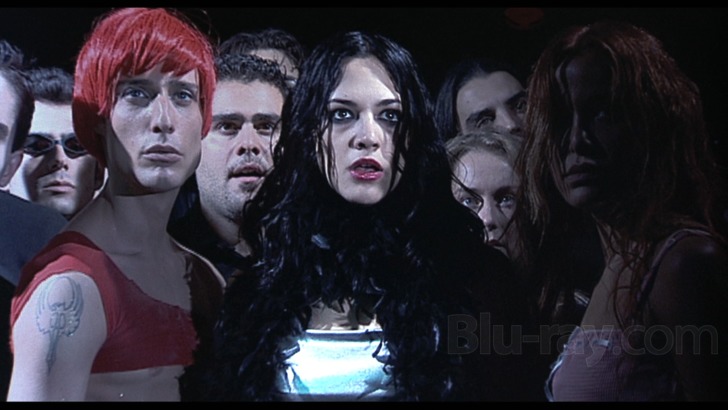
Scarlet Diva centers on an Italian actress named Anna Batista (Argento), whose life closely mirrors that of her creator, who was 23 when she began shooting the film. Anna is successful, sought after, and smiles obligingly for talk show hosts, paparazzi and insistent fans, but it's not a life she wants. Exactly what kind of life she does want is the central question in Scarlet Diva, as Anna travels across Europe, visiting friends, scoring drugs, throwing herself into night life—always in search of something she can't identify. She thinks of herself as "the loneliest girl in the world", and flashbacks to her childhood reveal some of the sources of the emptiness inside her: a severe and disapproving mother (played by Argento's real mother, Daria Nicolodi, who the actress says was not nearly as bad as the film portrays her) and a beloved older brother (Leonardo Servadio), who died of unspecified causes when Anna was still a child. (The character is based on the star's half-sister, who was killed in a motorcycle accident.)
While taking meetings she isn't interested in and testing for parts she doesn't want, Anna also begins to develop the outline of her own film, which she wants to direct. Her hope of finding financial backing is what lures her into the clutches of the Weinstein-like Mr. Paar (Joe Coleman), who quickly reveals his true intentions once they are alone in his hotel room. In the film, Anna escapes and a naked Paar pursues her wildly through the halls. It's a farcical version of an encounter from which, in real life, Anna's creator did not escape.
But the unwanted attentions of Mr. Paar are only one chapter in Anna's sexual adventures. She has a vigorous coupling with a co-star in her trailer; accedes to the erotic demands of a stranger calling herself Quelou (Selen), who appears in Anna's apartment one afternoon because she has a free half-hour; and falls for an American singer, Kirk Vaines (Jean Shepard), with whom she locks eyes during a performance. They exchange minimal words before their bodies connect, and Anna believes she has found the love of her life. She will spend the rest of the film waiting to join Kirk in his Australian home once his tour is finished. It's an extreme case of mad, youthful passion that can only lead to crushing disappointment. (For a tamer, male version, see Summer of '42.) While waiting for Kirk, she continues her quest for film work she finds meaningful and indulges in a variety of drugs (and other pursuits) to numb the pain of her frustration and longing.
Scarlet Diva is a messy tale, with episodic plotting that veers wildly among past, present, fantasy and dreams and a tone that shifts rapidly from comedy to melodrama to horror (and sometimes a bit of everything, as in the masochistic love affair between Anna's self-obsessed friend and the abusive boyfriend who leaves her tied up for three days, then beats her, only to have her fall into his arms). Nevertheless, the film is held together by a slender but traditional narrative thread of a young artist discovering herself and ultimately cobbling together from her experiences an initial work—in this case, a film script that is appropriately titled "Scarlet Diva". The film has the raw emotional intensity of a creator and main character who is not embarrassed to reveal the depth of her feelings and the extent of her follies. Argento observes in her new commentary that younger girls are the audience who most readily "get" the film and that, now in her forties, she no longer feels like Anna. But Scarlet Diva remains a powerful record of a unique artistic sensibility in its earliest expression. You may not like the film, but it's not one you can easily forget.
Scarlet Diva Blu-ray Movie, Video Quality 
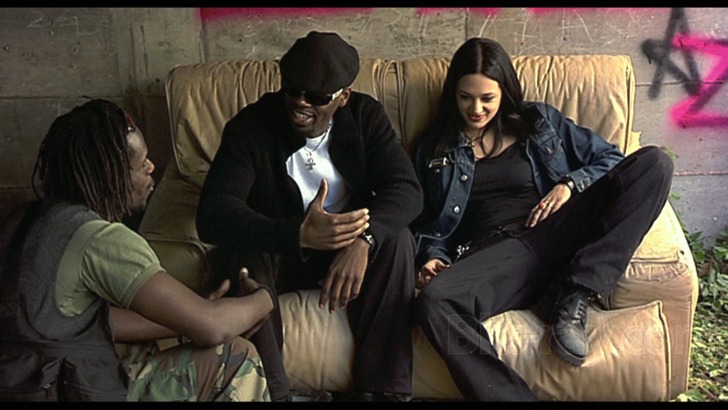
The 2018 re-release of Scarlet Diva has been widely touted as based on an "HD restoration", but
it's important to understand what is being "restored" and how. The film was shot on mini-DV
cameras long before digital cinematography had progressed to the point it has reached today—and it was shot in standard definition.
(The credited
cinematographer was Frederic Fasano, who has since gone on to shoot such films as Giallo for
Argento's famous father, Dario.) Scarlet Diva's origination on SD video means that any
presentation, no matter how it may be described, will be limited to a resolution less than that of
16mm film (or possibly even Super8). An additional limitation is the fact that the film was not
completed on a digital intermediate, because in 2000 that now-routine form of post-production
was only in its infancy (the first American
film to be finished on a DI appeared the same year as
Scarlet Diva). For the film's original release, the SD footage was blown up from the original
Betacam recordings to 35mm. As Argento describes it, the digital images were "tattooed" onto
film. When Film Movement says that this new "HD restoration" was sourced "from the original
35mm elements", the process sounds suspiciously like a standard film-to-1080p transfer, the kind that
studios have been doing with their catalog titles for years.
The image on Film Movement's 1080p, AVC-encoded Blu-ray is consistent with this history,
with signs of the 35mm source immediately evident from the opening titles. Telltale speckles and
the instability known as "gate weave" are visible, reflecting the analog detour taken by Scarlet
Diva between its digital origination and its current incarnation on digital disc. Also reflecting the
35mm intermediary is the copious grain, which varies from shot to shot, but is typical of what
happens when a low-res image is blown up to 35mm and then transferred to HD. Sharpness and
detail are equally variable, but even at their best, they can never exceed the limitations of SD
video. The blacks are a plus, rendering deep and solid backgrounds (e.g., during Anna's screen
test to play Cleopatra) as well as Argento's jet black hair (which isn't her natural color).
Despite its limitations, the image is able to convey the film's many expressive performances by
both its star and her supporting cast. (It helps that so much of the acting is "big" and theatrical.)
Anyone who remembers home movies from the earliest days of consumer video cameras knows that
standard definition is good enough to effectively capture locations (all of them "stolen" without
permits), interiors and people, even if it can't convey the textural detail of HD and UHD formats.
The image's greatest strength is its bold use of color, which Argento deploys with the instincts of
a filmmaker who literally grew up in the business. The dull tones of everyday life contrast
sharply with the bright washes, usually red or blue (or both), of dreams, drug-fueled visions and
intensely emotional experiences like the initial and final encounters between Anna and Kirk. The
colors may not "pop", but they're expressive. A high average bitrate of 33.99 Mbps with a
careful encode has ensured that the disc mastering does not add digital artifacts to the film's
already-challenging image.
Viewers who only look at the screenshots accompanying this review and do not take the time to
learn how Scarlet Diva was shot and the technical limits dictated by its origination might simply
dismiss the Blu-ray as a botch job, much as they still do with 28
Days Later, which was made in
standard definition DV two years after Argento's film. Such reactions may be unavoidable, but they are
unfortunate. Scarlet Diva is quintessential "guerilla" filmmaking, shot for pennies and finished
without support from any studio or industry backing. It deserves to be seen and appreciated "as
is", and Film Movement's Blu-ray delivers that experience as effectively and accurately as
possible. The video score accompanying this review is weighted for fidelity to the source.
Scarlet Diva Blu-ray Movie, Audio Quality 
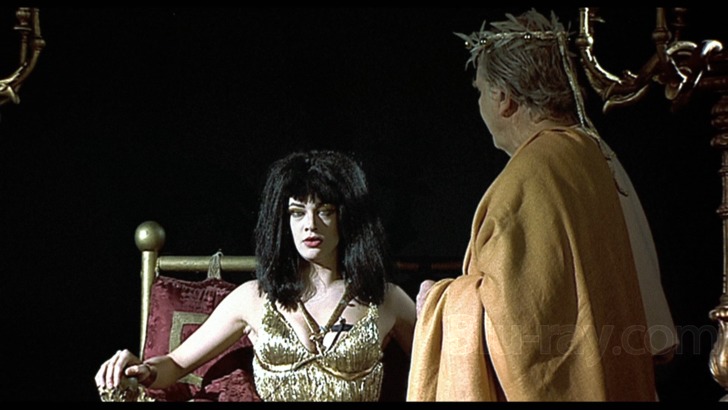
According to IMDb, the audio release format of Scarlet Diva's soundtrack was "Dolby Digital", but I suspect this simply refers to the technical process by which the sound was encoded onto 35mm prints. The track is primarily a mono affair, with mostly production sound for dialogue and environmental ambiance and a few special effects added in post (e.g., the subjective slowing down of perception when Anna snorts "Special K"). The Blu-ray's audio has been encoded in lossless PCM 2.0, and there is stereo separation evident in many of the musical selections, both the score composed by John Hughes (son of The Breakfast Club's director) and several key musical selections, notably Nina Simone's "Wild Is the Wind", the rights for which were one of the project's biggest expenses. The dialogue is a mixture of English, Italian and French, and there is an English subtitle track for the latter two, as well as an option for a separate English SDH track. The words are remarkably clear and intelligible, especially considering how often voices overlap. The track is no audio masterpiece, but it appears to be an accurate representation of the original, and as with the video, my score is weighted for accuracy.
Scarlet Diva Blu-ray Movie, Special Features and Extras 
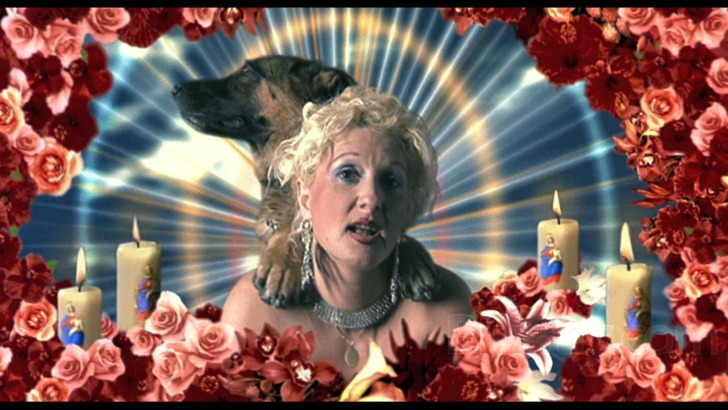
Scarlet Diva was released on DVD by Shriek Show in 2004. The commentary and interview
from that disc have been ported over to Film Movement's Blu-ray, along with a new commentary
and several other interesting extras.
- Commentaries with Writer/Director/Star Asia Argento: Listening to these two
commentaries back to back is an interesting experience that tells you as much about the
film's creator as about the film itself. Substantively, the two commentaries overlap in
many respects, with Argento pointing out the same shots as "stolen", identifying the same
players who are friends or famous actors doing her a favor, and indulging the same
grudges (notably, for the real-life Kirk, who broke her youthful heart, and for Vincent
Gallo, who reneged on his initial agreement to play the character).
The most notable difference is that of perspective acquired in the fourteen years between the two commentaries, much of it informed by Argento's experience of motherhood. She can also be more frank and angry about her abuse by Harvey Weinstein, whom she now mentions by name but more often identifies with epithets and expletives. You can hear the weight of the intervening time in the deeper intonations and huskier voice of Argento's new commentary (her smoking is no doubt a factor). At some points she seems almost nostalgic for the lost innocence of youth; at other time she seems grateful to have left it behind. In both commentaries, though, you get the same passionate and unapologetic soul, whose attitude is "This is who I am; if you don't like it, get the f*** out!". - 2018 Commentary
- Original Release Commentary (2004)
- Looking into the Eye of the Cyclops with Joel Coleman (1080p; 1.78:1; 8:01): Coleman played the Weinstein stand-in, Mr. Paar. He is also a painter and sculptor. In this new interview, he provides a detailed tour of an elaborate installation called "Eye of the Cyclops", which he describes as "an altar to the god of television". The work was created after he appeared in Scarlet Diva and contains a hidden tribute to the film.
- Asia Argento Original Release Interview (480i. 1.33:1; 16:58): This interview dates from 2004. Though only a few years had passed, Argento is already treating the film as part of her distant past, perhaps reflecting the birth of her first child, a daughter, in 2001. Prompted by an unidentified interviewer off-camera, Argento covers many of the same subjects she discusses in her commentaries.
- Making of Scarlet Diva (480i; 1.33:1; 8:28): This promotional featurette appears to date from the time of the film's release and focuses primarily on the digital shooting format, which was then a novelty. Interviewees including Argento, her uncle Claudio and father Dario (the film's producers), and DP Frederic Fasano. Italian, with English subtitles.
- 2018 Theatrical Trailer (1080p; 1.78:1; 1:35): In English and Italian, with English subtitles.
- Original Release One Minute Promo (480i; 1.85:1; 1:01): Voiceover in English; the titles are in Italian.
- Original Release Eight Minute Promo (480i; 1.33:1; 8:04): A mixture of film excerpts and behind-the-scenes footage; the latter are not subtitled. The image reflects a slight squeeze, perhaps because it was originally intended to be expanded to 1.78:1 for DVD playback.
- Film Movement Trailers
- About Film Movement: A promotional text screen.
- Booklet: This 20-page insert contains production stills, film credits and a detailed essay by film writer Kier-La Janisse, who analyzes the film as a "Heroine's Journey". Note that the list of chapter titles on page 3 is that of the disc, not the booklet, which has its own lengthy subheadings for each portion of the essay.
Scarlet Diva Blu-ray Movie, Overall Score and Recommendation 

Scarlet Diva may not rank as a great film, but it's an unforgettable debut from a fiery and original
voice. There's so much more to it than just the restaging of Argento's abuse by Weinstein, and it
would be unfortunate if that now-infamous event were allowed to overshadow Argento's aching
portrait of a young woman's painful discovery of hard truths and the shattering of her romantic
illusions. The Blu-ray isn't pretty, but it's a faithful rendition, and the collection of extras is
excellent. Recommended.
Similar titles
Similar titles you might also like

Porno Nights of the World N.2
Le notti porno nel mondo nº 2
1978

Black Emanuelle nº 2
Emanuelle nera nº 2 / The New Black Emanuelle
1976

Porno Esotic Love
Sexy Erotic Love
1980

Vibrations
1968

Whore
Kino Cult #25
1991

The Zone
2011

LA Plays Itself: The Fred Halsted Collection
Standard Edition
1972

Scandalous Emanuelle
Voglia di guardare
1986

Black Emanuelle
Emanuelle nera
1975

Sister Emanuelle
Suor Emanuelle
1977

Score
Uncut & uncensored
1974

Her Body
Její telo
2023

Forbidden Letters
1979

Camille 2000
1969

Maid in Sweden
1971

La chica que cayó del cielo
Melody of Passion
1986

The House of Lost Women
Le casa de las mujeres perdidas
1983

Appassionata
Limited Edition to 3000
1974

Crash
1996

Story of Sin
Dzieje grzechu
1975
